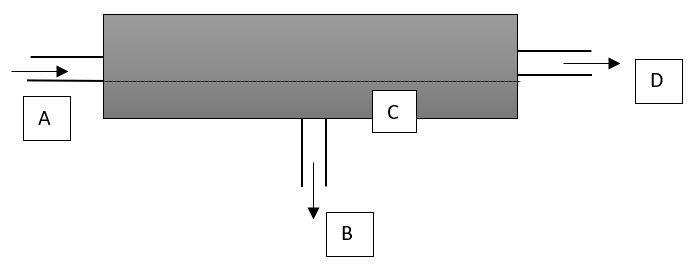This set of Bioseparation Engineering Multiple Choice Questions & Answers (MCQs) focuses on “Ultrafiltration”.
1. The membrane used for the process of ultrafiltration retains _____________
a) micro-molecular solute
b) macromolecular solute
c) concentrated solute
d) solvents
View Answer
Explanation: The macromolecular solutes are retained by the membrane used in the process of ultrafiltration and the solute retention can be determined by the size of the solute.
2. The other factor that retains the solute is ___________
a) solute-solute interaction
b) solute-solvent interaction
c) solvent-solvent interaction
d) no interaction
View Answer
Explanation: The other factors along with the characteristics of the membrane that retains the macromolecules are solute-membrane as well as solute-solute interaction.
3. The wide application of ultrafiltration is __________
a) concentration
b) purification
c) fractionation
d) processing
View Answer
Explanation: The wide application of ultrafiltration is in processing of various products such as drugs, hormones, enzymes, vaccines, antibodies and blood products.
4. The other major areas of ultrafiltration includes ___________
a) Purification
b) Concentration
c) Purification and concentration and desalting
d) Purification, concentration
View Answer
Explanation: The process of ultrafiltration is used in purification of proteins and nucleic acids, concentration of macromolecules, removal of salts from solution of macromolecules and removal of virus from therapeutic products.
5. The process of ultrafiltration separates the macromolecules of weight range of _________ molecular weight.
a) 1-2 kDa
b) 2-5 kDa
c) 5-10 kDa
d) 5-500 kDa
View Answer
Explanation: The molecular weight range for separation of macromolecules through ultrafiltration is 5 to 500 kDa and the membrane used for the separation has pore size of 1 to 20nm in diameter and those membranes are antistopic, having 10 micron thickness that is fused on the top of a layer which is microporus.
6. The characteristic of ultrafiltration membrane to retain the macromolecule is known as ___________
a) MCWO
b) MWCO
c) WMCO
d) COMW
View Answer
Explanation: MWCO means Molecular weight cut off and is the traditional term used for the retention of the macromolecules through ultrafiltration membrane and the value of MWCO is around 10kDA that represents 90% of molecules retention for the molecule of 10kDa in the membrane from the feed solution.
7. The flow of a solvent through ultrafiltration membrane are described in terms of ___________
a) pore flow
b) pressure drop
c) concentration of solute
d) molecular weight
View Answer
Explanation: The pore flow model is used for describing the flow of solvent through an ultrafiltration membrane. The model assumes that the ideal cylindrical pores of the membrane are aligned normally to the surface of the membrane.
8. The model equation for the flow of solvent through the ultrafiltration membrane is given by ________
a) Jv = \(\frac{\varepsilon_m d_p^2 \Delta P}{2\mu l_p}\)
b) Jv = \(\frac{\varepsilon_m d_p^2 \Delta P}{3\mu l_p}\)
c) Jv = \(\frac{\varepsilon_m d_p^2 \Delta P}{\mu l_p}\)
d) Jv = \(\frac{\varepsilon_m d_p^2 \Delta P}{32\mu l_p}\)
View Answer
Explanation: The correct equation for the model is Jv = \(\frac{\varepsilon_m d_p^2 \Delta P}{32\mu l_p}\) where, Jv is volumetric permeate flux, εm is membrane porosity, \(d_p^2\) is average pore diameter, ΔP is transmembrane pressure, μ is viscosity and lp is average pore length.
9. What is the significance of the given diagram and label it.

a) Cross-flow membrane filtration. A-Feed, B-permeate C-Membrane D-retentate
b) Membrane filtration. A-Feed, B-permeate C-Membrane D-retentate
c) Cross-flow membrane filtration. A-retentate, B-permeate C-Membrane D-Feed
d) Membrane filtration. A- Feed, B-Membrane, C-permeate, D-retentate
View Answer
Explanation: The given diagram is of cross-flow membrane filtration as the process of ultrafiltration operates in the cross-flow mode and the feed flows parallel to the surface of membrane. The feed (A) enters flows through the membrane (C), retentate (D) is collected and permeate (B) is separated from the membrane.
10. The trans-membrane pressure in cross-flow ultrafiltration is given by ___________ equation.
a) ΔP = \(\frac{P_i + P_0}{2}\) . Pp
b) ΔP = \(\frac{P_i + P_0}{2}\) + Pp
c) ΔP = \(\frac{P_i + P_0}{2}\) – Pp
d) ΔP = \(\frac{P_i + P_0}{2}\)
View Answer
Explanation: The equation for the cross-flow ultrafiltration in the terms of the trans-membrane pressure is ΔP = \(\frac{P_i + P_0}{2}\) – Pp where, Pi is inlet pressure on the feed side, P0 is the outlet pressure on the feed side, Pp is the pressure on the permeate side. The trans-membrane pressure is generated by the pressure generated in the feed side with a valve that is on the line of retentate.
Sanfoundry Global Education & Learning Series – Bioseparation Engineering.
To practice all areas of Bioseparation Engineering, here is complete set of 1000+ Multiple Choice Questions and Answers.
If you find a mistake in question / option / answer, kindly take a screenshot and email to [email protected]
